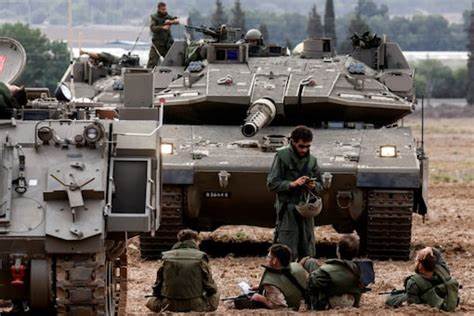Fierce street-by-street combat rages in Gaza City
Israeli troops and Hamas were locked in heavy, close-quarters fighting in Gaza City on Thursday, including a 10-hour battle that Israel said toppled one of the Palestinian militants’ “strongholds”. Hamas fighters armed with rocket-propelled grenade launchers and assault rifles were clashing with Israeli soldiers backed by armoured vehicles in the ruins of the besieged territory’s […]

FILE PHOTO: Israel soldiers in Gaza
Israeli troops and Hamas were locked in heavy, close-quarters fighting in Gaza City on Thursday, including a 10-hour battle that Israel said toppled one of the Palestinian militants’ “strongholds”.
Hamas fighters armed with rocket-propelled grenade launchers and assault rifles were clashing with Israeli soldiers backed by armoured vehicles in the ruins of the besieged territory’s north.
Broken palm trees, mangled road signs and twisted lampposts marked the remains of what was once north Gaza’s main arterial route, an AFP journalist saw while embedded with Israeli troops on a controlled visit.
Israeli flags were flying over buildings at beach resorts in northern Gaza and there was little sign of any human presence amid the destruction as hundreds of thousands have fled a dire humanitarian situation.
- Hajj 2024: Kaduna begs clerics to sensitise intending pilgrims on Dec 31 deadline
- NBTE boss calls for national skills fund to empower informal sectors
The utter devastation is the result of over a month of war sparked by the October 7 Hamas attacks on Israel.
On that day, gunmen from the Islamist group poured over the Gaza border with Israel and, according to Israeli officials, killed 1,400 people and seized about 240 hostages in the worst attack in the country’s history.
Vowing to destroy Hamas, Israel retaliated with an aerial bombing and ground offensive that the health ministry in the Hamas-run Gaza Strip says has killed more than 10,500 people, many of them children.
Stronghold and tunnels
The Israeli military said its forces secured a Hamas “military stronghold” in the western Jabalia area in the past day, adding the troops had “finished securing the compound after 10 hours of combat”.
The battle raged above and below ground, it said, exposing some of Hamas’s extensive network of tunnel and subterranean bases that form a significant element of the militants’ capacity to fight.
Israel said dozens of militants were killed while adding the overall death toll for Israel’s troops in the ground offensive had risen to 34.
The intense combat and the densely populated coastal territory being effectively sealed off have led to increasingly dire conditions for civilians.
French President Emmanuel Macron urged nations to “work towards a ceasefire” between Israel and Hamas in Gaza, as he opened a conference in Paris on aid to the Palestinian territory.
Israel won’t attend the meeting, which aims to mobilise the main players involved in the humanitarian response in the Gaza Strip.
Tom Potokar, chief surgeon at the International Committee of the Red Cross, described the scene at the European hospital in Khan Yunis in southern Gaza as “catastrophic”.
“In the last 24 hours, I’ve seen three patients with maggots in their wounds,” Potokar told AFP.
A rare delivery of emergency medical supplies reached Gaza City’s main Al-Shifa hospital on Wednesday, just the second since the war began, the UN and World Health Organization said, warning it “far from sufficient to respond to the immense needs”.
Thousands fleeing fighting
The army said 50,000 people had fled their homes in the main battle zone of northern Gaza on Wednesday, a sharp increase in numbers from earlier this week, adding to the more than 1.5 million people already seeking safety in the south of the coastal strip.
The UN Office for the Coordination of Humanitarian Affairs (OCHA) confirmed the figure and warned conditions were desperate in battle zones north of the central Wadi Gaza district.
“Hundreds of thousands of people remaining north of Wadi Gaza, including IDPs (internally displaced people), are facing a dire humanitarian situation and are struggling to secure the minimum amounts of water and food to survive.”
